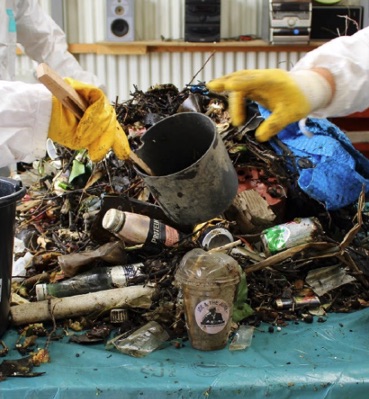
Credits The Great Bubble Barrier
Each year 1.8 million tons of plastic enter our oceans via rivers. Once lost at sea, plastic is almost impossible to retrieve and degrades into smaller particles.
How can we fight against this plastic pollution in the oceans? Scientists have discovered that 80% of the plastic waste found in the ocean is discharged by more than a thousand rivers, and that most of this waste is transported by small streams in densely populated urban areas, rather than by larger rivers. This finding is crucial to understanding and solving the problem of plastic waste.
This is a major issue in Portugal, where the Porto region is home to two of the most plastic-polluted rivers in Portugal, including the River Ave (around 10 tons of plastic are discharged there every year).
The ENGIE Foundation wanted to contribute to this issue by betting on innovation and supporting the initiative of The Great Bubble Barrier, a Dutch start-up founded in 2017, to set up an innovative system to combat plastic waste in rivers, a Bubble Barrier in the Porto region of Portugal.
The 25th of November, this new Bubble Barrier has been inaugurated on the river Ave in the city of Vila do Conde
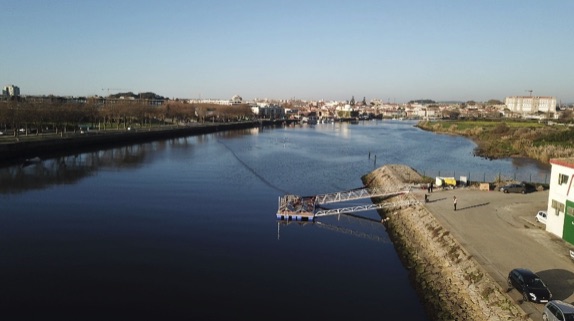
Credits The Great Bubble Barrier
This Bubble Barrier is the first one installed outside the Netherlands by the Dutch start-up after the two first Bubble Barriers in operations in Amsterdam (2019) and in the region of Katwijk (2022).
According to preliminary studies, the Bubble Barrier can catch up to 86% of debris in the Ave River, before it flows into the Atlantic Ocean.
Technology
By injecting air into a perforated pipe at the bottom of the stream (1), a wall of bubbles generates a vertical current. This brings the plastic to the surface, then directs it to the bank where it is collected by a recovery system (2) placed at the river’s edge.
Bubble Barrier is a unique, innovative and environmentally friendly system.
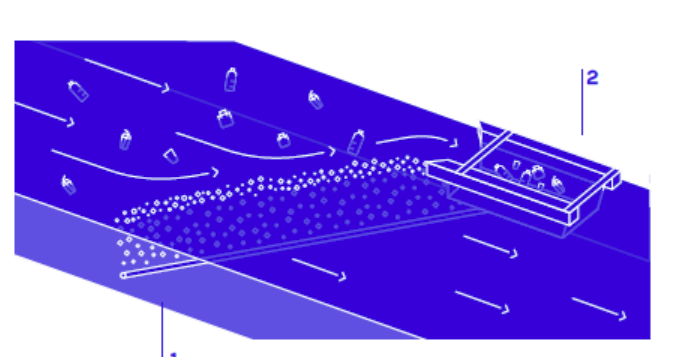
Credits The Great Bubble Barrier

This project in Portugal was developed as part of MAELSTROM (Smart technology for MArinE Litter SusTainable RemOval and Management), a major EU-funded project supporting innovative technologies for the removal and treatment of plastic pollution in river ecosystems. It has been developed by a consortium of 14 partners (including research centers, recycling companies, NGOs, marine scientists, and robotic experts from 8 European countries), in charge of specific tasks (assessing the presence of waste in rivers, removing waste, recycling…).

Credits The Great Bubble Barrier
A Bubble Barrier in an estuary
The Ave River ends in an estuary meaning that the incoming tide brings a flush of salt water into the river mouth twice a day, thereby reducing or even reversing the flow direction, and increasing the water level by roughly 2.5 meters…
The Bubble Barrier Vila do Conde is the first project in an estuary. The results of the pilot will be evaluated after 1 year of operation. With this project, The Great Bubble Barrier aims to realize a standard design for more tidal rivers in the future.
Interview with CARLOS ROSARIO, CEO of ENGIE Portugal
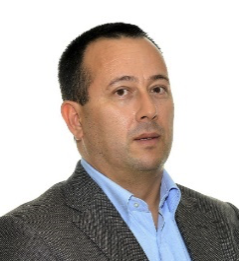
Carlos, could you present briefly the activities of ENGIE Portugal?
ENGIE Portugal is a leading company in the field of energy transition. ENGIE is present in the country since 1983 in electricity production and energy services and we provide our customers with solutions that foster energy and environmental sustainability through the generation of renewable and thermal energy, the district heating and cooling system in Lisbon and energy solutions to tertiary and industrial clients.
- ENGIE is the 2nd player in the country in electricity production with more than 4 GW of installed capacity: 1.9 GW of thermal capacity (TrustEnergy), 1.7 GW of hydroelectric capacity (Movhera) & 513 MW of wind capacity.
- ENGIE Portugal is also operating the largest district heating and cooling system of Portugal (Climaespaço in Lisbon).
- ENGIE Portugal (trough ENGIE Hemera) is also a specialist of medium and large-scale decentralized solar photovoltaic systems for B2B customers (with more than 30 MW installed)
- ENGIE Portugal is a reference in the provision of energy efficiency services and in the operation and maintenance of technical facilities for industrial and tertiary sector customers.
Could you tell us about the challenges ahead for ENGIE in Portugal?
In renewables, we intend to grow with new projects and upgrade the capacities of the existent assets with modernization, hybridization, repowering and overpowering.
In Flexible Generation, we will proceed in the decarbonization path of the actual sites.
In Energy Services, developing innovative low-carbon solutions for our clients is the core of our growth ambition, in areas like Onsite Utilities, Distributed Solar & Storage, Districts Heating and Cooling systems and Energy Efficiency Services.
What about the interest for ENGIE Portugal in the Bubble Barrier project in Villa do Conde?
Considering the group commitment with the UN Sustainable Development Goals (SDG), such as SDG N°14 “Life Below Water”, ENGIE Portugal is also aligned with these major international principles in favor of preserving the environment. Therefore, supporting the implementation of The Great Bubble Barrier’s innovative technology is an opportunity for us to act in the fight against a global environmental problem, that is the riverine plastic pollution, contributing to conservation and sustainability of natural resources. It is also important for us to demonstrate the ENGIE’s presence in Portugal and disseminate our great CSR values through the community and our stakeholders.
INTERVIEW WITH PHILIP EHRHORN, Chief Technology Officer and Co-Founder of The Great Bubble Barrier

Philip, how was the idea of Bubble Barrier born?
The other three co-founders of The Great Bubble Barrier, Anne Marieke Eveleens, Francis Zoet and Saskia Studer, are lifelong sailors and friends who constantly came across plastic at sea on their sailing trips. When they were having a beer after one of their trips, they started mulling over ways to tackle plastic pollution. They dreamt of a solution that would target plastic but would not hinder ship traffic or fish migration. The bubbles in their drinks eventually sparked their imagination, their concept and prototype were awarded and soon they started testing and developing their first prototypes further.
At the same time, I was developing my own Bubble Barrier in Germany. During a course in Environmental Engineering, I visited a wastewater treatment plant where I saw bubbles being used to aerate the water basin. The plastics that were present were pushed to the side of the basin. So, I wondered: “Why can’t we use the power of bubbles to capture plastic in rivers?”
Eventually, the four of us met. We decided to join forces and co-founded The Great Bubble Barrier in 2017.
After five years of R&D and pilots, our team developed the world’s first Bubble Barrier technology to effectively capture plastic in rivers. The first long-term Bubble Barrier was installed in the canals of Amsterdam in November 2019, followed by Katwijk in 2022. Bubble Barrier Vila do Conde, is the first Bubble Barrier outside of the Netherlands.

Other Bubble Barriers in operation in the NetherlandsCredits The Great Bubble Barrier
Why the choice of this site in Portugal?
The problem of riverine plastic pollution is universal: plastic debris is transported by rivers, crossing national and political borders, before reaching oceans.
The Ave River was chosen because the river needed a solution to plastic pollution without interfering with daily river activities. The Ave River has its source in the Cabreira Mountain in the Minho Region. In its course it passes through the cities of Guimarães, Vizela, Santo Tirso, Trofa and finally Vila do Conde, and carries plastic pollution into the Atlantic Ocean.
Bubble Barrier Vila do Conde is the first Bubble Barrier to directly stop plastic pollution from flowing into the Atlantic Ocean.
What interactions with the other parties involved (MAELSTROM consortium, Municipality, University of Malta…)?
The Municipality of Vila do Conde has taken a proactive approach to plastic pollution by partnering with the MAELSTROM team to co-design and implement a Bubble Barrier in the Ave River.
Indeed, the Bubble Barrier has been implemented as part of the EU-funded project MAELSTROM, which brings together a consortium of 14 international partners with the mission to investigate and implement innovative technologies for the identification, collection, recycling, and recovery of marine litter.
The project was undertaken with the scientific supervision of the Italian Research Council (CNR), project coordinator, and CIIMAR – Interdisciplinary Centre of Marine and Environmental Research – a leading research and advanced training institution of the University of Porto, which has led multiple assessments to understand the environmental impact of the Bubble Barrier on Ave’s riverine ecosystem.
CIIMAR has also facilitated the involvement of other local stakeholders such as the Docapesca Portos e Lotas, S.A., the Portuguese Environmental Agency, the Vila do Conde Port Captaincy and the Vila do Conde Environmental Monitoring and Interpretation Centre (CMIA) which were extremely relevant for the design and implementation of the system.
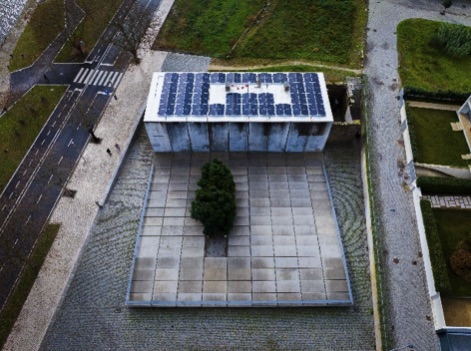
Credits The Great Bubble Barrier
The energy supply of the Bubble Barrier will be co-powered through solar panels installed by the University of Malta, another key partner of the MAELSTROM project. The University of Malta designed a tailored solar panel system – both inland and floating – connected to the Bubble Barrier compressor and the CMIA and Municipal Pool buildings in Vila do Conde. The system is expected to generate 57,300 kWh of renewable energy in the first year of operation, compensating for part of the electricity required by the Bubble Barrier from the electricity grid.
How do you see the support of the ENGIE Foundation and ENGIE Portugal ?
In order to tackle the problem of plastic pollution we need the collaboration of many stakeholders, from the private sector to the government.
We cannot implement Bubble Barrier projects without partners like the ENGIE Foundation and ENGIE Portugal, who support our mission of plastic-free rivers. We are extremely grateful for their operational and financial support in making Bubble Barrier Vila do Conde possible.




